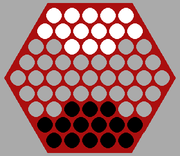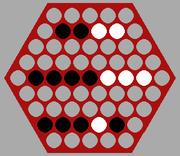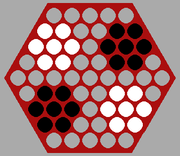Abalone (board game)
|
|
Abalone is a two-player strategy board game which can be quaintly summarized as "sumo wrestling with marbles", as the objective is to push opposing marbles off the edge of the board. The rules can be mastered in a minute or two, and the flow of the game is fast-paced. Abalone tends to draw in new players much more quickly than complicated, slow games such as chess. Also, pushing the marbles is physically satisfying. The click-click-click as one's marbles push the enemy back is almost musical.
The board consists of 61 circles arranged in a hexagon five on a side. Each player has fourteen marbles which rest in the circles, and are initially arrayed as shown at left.
Abalone_inline.png
The player with the black marbles moves first. The marbles are moved in lines of one, two, or three, either inline (parallel to the line of marbles) or broadside (not parallel to the line of marbles), as illustrated at left.
Abalone_push_before.png
Abalone_push_after.png
When one player has numerical superiority in a line (three to two, three to one, or two to one) he or she may push the opposing marbles with an inline move. Broadside pushes are not allowed. The winner is the first player to push six opposing marbles off the edges of the board. The diagrams at left illustrate three Black pushes, before and after pushing.
The diagram at left illustrates three situations in which it is impossible for Black to push. In the top line Black does not have numerical superiority. In the middle line, Black has four marbles to three, but a maximum of three marbles may be moved each turn, so again no push is possible. In the bottom line Black cannot push because it is forbidden to dislodge one's own marbles.
The notation for recording moves gives the letters A-I to the horizontal lines, and the numbers 1-9 to northwest-southeast diagonals.
I O O O O O
H O O O O O O
G + + O O O + +
F + + + + + + + +
E + + + + + + + + +
D + + + + + + + + 9
C + + @ @ @ + + 8
B @ @ @ @ @ @ 7
A @ @ @ @ @ 6
1 2 3 4 5
An inline move can be denoted by the movement of the trailing marble. Notation for broadside moves is a little more complex: denoted by the initial positions of the two extremities of the row followed by the final position of the first one (thus, each broadside move has two notations possible).
Abalone_midgame_1.png
Here are some moves from a sample midgame. No marbles have yet been ejected in the first position.
Abalone_midgame_2.png
Abalone_midgame_3.png
Abalone_defense.png
Unfortunately, the dynamics of the basic game may have one serious flaw: a good, conservative player seems to be able to set up his or her marbles in a defensive wedge, and ward off all attacks indefinitely. An attacker may try to outflank this wedge, or lure it into traps, but such advances are often more dangerous to the attacker than the defender (a high level is needed). Though, nowadays good players are more focused on attacking than defending; those who defend are weaker and generally lose against them. Nevertheless, it remains a problem, as average players playing together often miss some possible attacks and reach a stable configuration.
There are several solutions to this conundrum. First, in tournaments, a judge may penalize a player for playing defensively. This solution is somewhat unsatisfactory, given that a judge may not always be present, and that "defensive play" is a subjective notion.
Second, several variations of the rules of play have been developed for the same board and marbles. Unfortunately, none of the variations has the same appealing simplicity of the original.
Third, and perhaps best, alternative starting positions have been designed to make the formation of stalemate wedges less likely. Experiments are still underway to find an opening position which neither devolves into a draw, nor gives too great an advantage to the first player. One popular attempt is the marguerite position, which is displayed on the left in its German version.
Abalone can also be played by three persons (or more) using the same board with fewer marbles each in three different colours.
External link
- AbaloneGames.com (http://www.abalonegames.com/) - The official site in English, French, and German
- NetAbalone (http://netabalone.goto-games.com/) - Download the game module to play online
- Forum (http://90214.aceboard.net/) - A forum about Abalone with exercises to solve (French/English)
- Mindgames (http://www.ihsan.biz/) - Freeware implementation of Abalone with computer opponentde:Abalone (Spiel)





